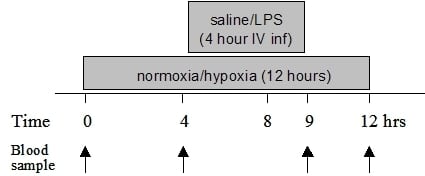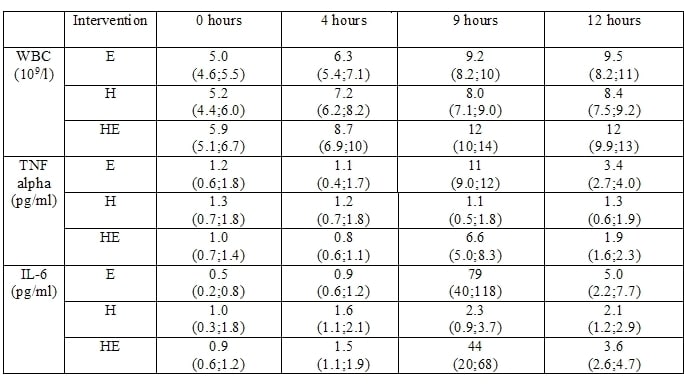Hypoxia frequently accompanies severe systemic inflammation and has been suggested to modulate the inflammatory response. The present study investigates the effect of acute hypoxia, a systemic inflammatory stimulus, or both on the systemic inflammatory response in healthy volunteers. 36 healthy male volunteers were randomised to one of the following interventions (Figure 1): 1. Normoxia + endotoxin infusion (0.075 ng/kg/hr, total dose 0.3 ng/kg, E; N=12); 2. Hypoxia (12.9%) + saline infusion (H; N=11); 3. Hypoxia (12.9%) + endotoxin infusion (HE; N=13). Vital signs were monitored throughout the study period, and the study was approved by the local ethical committee. White blood cell and differential counts (WBC), tumour necrosis factor-alpha (TNF) and interleukin (IL)-6 were measured at 0, 4, 9, and 12 hrs. Multivariate analysis of variance and Bonferroni-corrected post hoc tests were used to study the effect of time, intervention and the interaction between time and intervention. Temperature increased from baseline (E:36.3°C;H:36.2°C;HE:36.3°C) in all groups and peaked at 10 hours in the E (38.4°C) and HE (39.9°C) groups with no difference between groups. Levels were higher in both the E group and the HE group than in the H group from 9 throughout 12 hours (P<0.05). Heart rate increased from baseline (E:68 bpm; HE:69 bpm) and peaked at 10 hours in the E (93 bpm) and HE (101 bpm) groups. There was no difference between the E and HE groups. WBC and TNF increased in group E and HE. The increase was more pronounced in group HE than in group E with regard to WBC (P<0.05), and more pronounced in group E than in group HE with regard to TNF (P<0.01). IL-6 increased during all types of interventions, albeit more so in groups receiving endotoxin infusion (E and HE) than during hypoxia alone (group H). No difference was found with respect to increase in IL-6 between groups E and HE (Table 1). These results suggest, that acute hypoxia may modulate certain aspects of the systemic inflammatory response in humans.
University of Cambridge (2008) Proc Physiol Soc 11, PC33
Poster Communications: Systemic inflammatory response during endotoxaemia and acute hypoxia in humans
S. Taudorf1, R. M. Berg1, D. M. Bailey2, C. Lundby3, B. K. Pedersen1, K. Møller1,4
1. Centre of Inflammation and Metabolism, Department of Infectious Diseases and CMRC, Rigshospitalet, Copenhagen, Denmark. 2. Hypoxia Research Unit, Department of Physiology, University of Glamorgan, Pontypridd, United Kingdom. 3. Copenhagen Muscle Research Centre, Rigshospitalet, Copenhagen, United Kingdom. 4. Department of Cardiothoracic Anaesthesia and Intensive Care Unit 4131, Rigshospitalet, Copenhagen, United Kingdom.
View other abstracts by:
Values are mean (lower; upper 95% CI)
Where applicable, experiments conform with Society ethical requirements.


